The stages of psoriasis are certain time intervals during which the disease acquires its characteristic features. Many psoriatists mistakenly call the stage a severe or mild form of the disease, but in medical records the term is used in a completely different meaning.
What are the stages of psoriasis?
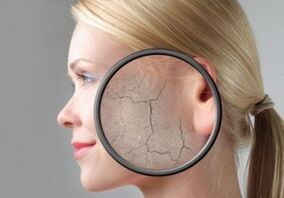
Psoriasis is recognized as a recurrent skin pathology caused by genetics. According to dermatologists, at least 2% of the world's population suffers from this disease, which means that the problem is very urgent. During psoriasis, 2 conditions are clearly distinguished:
- Relapse.This term refers to the deterioration of the skin. In case of recurrence, the patient suffers from itching, pain, burning, profuse skin eruptions, irritation and discomfort. The victim's condition is aggravated by insomnia, neurosis and anxiety.
- Remission.This word is used to mean improving the appearance of the skin. With remission, the skin regains its normal color, the redness disappears and the area of psoriatic plaques decreases.
The stages of psoriasis partially duplicate the description of remissions and relapses, so many dermatologists use these words interchangeably. In clinical practice, 3 stages of psoriasis have been described:
- stage of progress;
- stationary;
- regression stage.
Given that we are talking about a cyclical process, the stages successively flow into each other and form a continuous course of the disease.
Fact!The progress stage is considered the most difficult to feel.
What is the progression of psoriasis?
The progress phase is triggered by a number of triggers, such as the cold season or stress. In some cases, even an experienced dermatologist cannot unambiguously determine the trigger. During the progressive stage, the following happens:
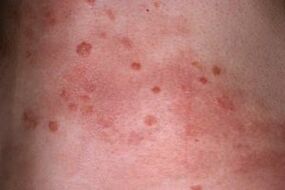
- Psoriatic nodules develop rapidly, affect the skin, bind in so-called plaques that flake and itch. The plaque is a place of any shape, most often round or oval, sometimes with an uneven edge.
- Papules, ie individual nodules of a psoriatic rash, are lumps on the skin. The ends of the papules do not peel off, and the central part peels off. With the accumulation of a large number of dead scales, plaques begin to rise above the surface of the skin. The puffiness gives them an even more prominent and uneven appearance.
- This stage of pathology is characterized by an isomorphic reaction, which consists in exacerbation of rashes with skin lesions, scratches, injections, cuts, microtraumas. This phenomenon is called Koebner.
The delayed reaction is characteristic of the progressive stage of psoriasis. In some cases, skin rashes appear about 9 days after exposure to the trigger (as a food allergen). The psoriatic rash usually appears within 24 hours after exposure to adverse factors.
Interesting!95% of psoriatics have some form of food intolerance that can cause relapse. To avoid exacerbation, you should keep a food diary and monitor the reaction to different types of food.
Stationary and recessive stages
The inpatient stage is the period in the course of psoriasis in which the victim's condition is relatively stable. At the stationary stage:
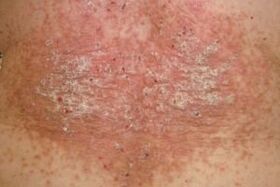
- Psoriatic plaques have a smooth contour. The entire surface of the plate is covered with a thick layer of flakes that peel off easily. Itching and discomfort are moderate. There is no bright red inflamed edge around the papules.
- In microtraumas of the skin, the Koebner phenomenon is not observed, ie scratching or cutting of healthy skin no longer turns into psoriatic plaque.
The regressive or recessive stage is characterized by massive lesions in psoriasis. First, a pseudoatrophic margin can be seen around the papules, and then patients notice a rapid cessation of skin flaking with the formation of hyperpigmentation plaques at the site.
Severity of pathology
An additional diagnostic criterion is the assessment of the area of psoriatic lesions. The term "weight" is used to describe it. Dermatologists distinguish 3 degrees of severity of skin disease:
- Easy.Psoriatic plaques occupy 1 to 3% of the total body area. The small size of the affected areas does not mean that the patient is doing well. With psoriasis of the head or face, even a few plaques will be enough to cause discomfort and grief to a person.
- Medium.The volume of psoriatic eruptions occupies from 3 to 10% of the total body area. In this case, the back, chest and outer surfaces of the joints, scalp, palms and feet are affected. This spread leads to severe intoxication and severe pain. The patient may completely or partially lose their ability to work, the mental state and the state of the nervous system deteriorate.
- Heavy.The disease covers more than 10-15% of the skin surface. According to rough estimates, if psoriasis occupies more than a quarter of the total body area, the likelihood of liver or kidney failure increases many times over. Decompensated damage to internal organs can cause the death of psoriasis.
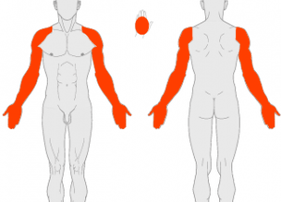
A special scale called PASI is used for an overall assessment of the severity of psoriasis. The scale takes into account:
- percentage of healthy and sick skin;
- stage of pathology;
- patient response to drug therapy;
- individual tolerance to psoriasis (mental condition, complications of the nervous system and psyche);
- objective data from laboratory tests in dynamics (eg uric acid volume in a blood test).
The diagnosis takes into account all the symptoms that affect the condition of a person with psoriasis. The intensity is reflected in the medical card:
- itchy skin processes;
- redness;
- puffiness;
- hyperemia;
- thickening of the skin;
- exfoliation;
- blood flow;
- swelling;
- infections;
- pain syndrome.
On the PASI scale, the volume of skin lesions is described by numbers from 0 to 72, where 0 is the absence of skin symptoms and 72 is the large-scale, maximum possible spread of the disease.
Attention!It is important for the patient to know and monitor the signs of exacerbation. If adverse symptoms occur, you should see a dermatologist immediately, because psoriasis does not always enter the inpatient stage. Recurrence can last for decades.
The treatment of psoriasis depends on the stage
A set of therapeutic measures has been developed for each stage of the disease, so the first thing a dermatologist determines is whether psoriasis is progressing, stabilizing, or regressing.How to treat the progressive stage
Every psoriasis sufferer assumes that remission ends with their own feelings. If the itching worsens, the skin looks worse and the psoriasis is clearly spreading on the surface of the body, treatment should begin. Advanced therapy has the following characteristics:
- The patient deals with the prevention of further deterioration of the condition, strictly adheres to the diet, refrains from triggering the pathological process (stress, smoking, alcohol).
- In severe itching, antihistamines may be used, an additional benefit of this class of drugs is the elimination of puffiness in the area of psoriatic plaques.
- Dermatologist prescribes a wide range of topical treatments to heal, soften and thin the skin. Creams, ointments or sprays are chosen at the doctor's discretion. Compresses of tar soap and hard oil give positive dynamics. You can also apply compresses or apply Dead Sea mud cosmetics.
The main task at this stage is to stop the exacerbation before the disease progresses to a prolonged relapse. According to the indications, the doctor chooses corticosteroids in injections or in the form of ointments.
Attention!Corticosteroids should be used in a short intensive course under the supervision of a dermatologist. You can get injections or apply antihistamine ointments.
Inpatient and regressive staged therapy
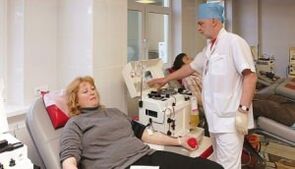
The further actions of the dermatologist depend on the body's response to the chosen treatment. The following scenarios are possible:
- The drug has a positive effect. Within 1-2 weeks, psoriasis passes the stationary stage, regresses and remission occurs.
- Medications have no effect. If after 2-4 weeks from the moment of prescribing the course of drugs, the results are still not visible, this is a reason to change either the list of drugs or the attending physician.
- The drug aggravates. Such dynamics are also possible, especially if the dose or frequency of administration is not sufficient. Recurrence slows down, psoriatic plaques cover a large part of the body, the person needs hospitalization.
A more powerful therapy, such as hardware blood purification, is used in a medical facility. With a favorable reaction, psoriasis enters a stationary stage, which can last from several days to several months.
Interesting!More than 80% of patients notice the seasonal nature of exacerbations. This makes the disease predictable and allows you to prepare for the onset of a relapse.
The list of drugs for the stationary and regressive stages is absolutely the same, but the dosage and frequency of administration are smaller than the progressive stage.
10-15 years of remission
A competent dermatologist sets himself the following task - to choose such drugs and physiotherapeutic agents that will give psoriatic patients the longest possible improvement. At the same time, the patient himself should do everything possible to promote treatment, avoid triggers and take medication responsibly. If the union between the patient and the doctor has developed successfully, then the duration of remission is unlimited. Stable wellness can last 15 years or more.























